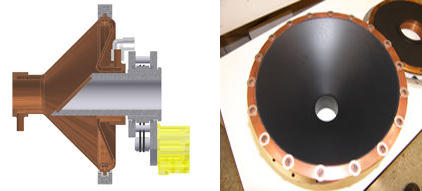
Carbon nanotubes (black coating in photo, right) form the inner lining of NIST's new laser power meter, enabling the copper instrument to withstand the intensity of military lasers while precisely measuring their power. Laser light is distributed evenly inside the water-cooled cavity by a mirror (diagonal component at center of graphic).
The U.S. military can now calibrate high-power laser systems, such as those intended to defuse unexploded mines, more quickly and easily thanks to a novel nanotube-coated power measurement device developed at the National Institute of Standards and Technology (NIST).
The new laser power meter, tested at a U.S. Air Force base last week, will be used to measure the light emitted by 10-kilowatt (kW) laser systems. Light focused from a 10 kW laser is more than a million times more intense than sunlight reaching the Earth. Until now, NIST-built power meters, just like the lasers they were intended to measure, were barely portable and operated slowly. The new power meter is much smaller—about the size of a crock pot rather than a refrigerator. It also features a new design that enables it to make continuous power measurements.
A key innovation is the use of a sprayed-on coating of carbon nanotubes—tiny cylinders made of carbon atoms—which conduct heat hundreds of times better than conventional detector coating materials.
In the new power meter, laser light is absorbed in a cone-shaped copper cavity, where a spinning mirror directs the light over a large area and distributes the heat uniformly. The cavity is lined with a NIST-developed coating made of multiwalled carbon nanotubes held together by a potassium silicate (water glass) binder, and surrounded by a water jacket. The coating absorbs light and converts it to heat. The resulting rise in water temperature generates a current, which is measured to determine the power of the laser.
NIST has developed and maintained optical power standards for decades. In recent years, NIST researchers have experimented with a variety of coatings made of nanotubes because they offer an unusual combination of desirable properties, including intense black color for maximum light absorption. Designing a detector to collect and measure all of the power from a laser intended to significantly alter its target is a significant challenge. The new power meter uses the latest version of NIST's nanotube coating, which absorbs light efficiently, is more stable than some conventional coatings such as carbon black, and resists laser damage as effectively as commercial ceramic coatings.
Among other test results, NIST has found that multiwalled carbon nanotubes perform better than single-walled nanotubes. Researchers are continuing to seek nanotube formulas that are durable and easy to apply, like enamel paint, but have even higher damage thresholds than today's coatings.
NIST's nanotube coating technology already has been transferred to industry for use in commercial products. Development of the new power meter was funded by the Air Force.
C.L. Cromer, K.E. Hurst, X. Li and J.H. Lehman. Black optical coating for high-power laser measurements from carbon nanotubes and silicate. Optics Letters. January 15, 2009, Vol. 34, No. 2.

